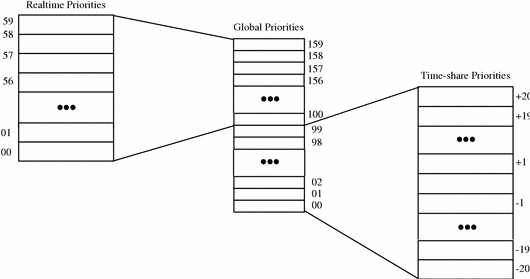Scheduling Classes
The SunOS 5.0 through 5.7 kernel dispatches processes by priority. The scheduler (or dispatcher) supports the concept of scheduling classes. Classes are defined as Realtime (RT), System (sys), and Time-Sharing (TS). Each class has a unique scheduling policy for dispatching processes within its class.
The kernel dispatches highest priority processes first. By default, realtime processes have precedence over sys and TS processes, but administrators can configure systems so that TS and RT processes have overlapping priorities.
Figure 9-4 illustrates the concept of classes as viewed by the SunOS 5.0 through 5.7 kernel.
Figure 9-4 Dispatch Priorities for Scheduling Classes

At highest priority are the hardware interrupts; these cannot be controlled by software. The interrupt processing routines are dispatched directly and immediately from interrupts, without regard to the priority of the current process.
Realtime processes have the highest default software priority. Processes in the RT class have a priority and time quantum value. RT processes are scheduled strictly on the basis of these parameters. As long as an RT process is ready to run, no sys or TS process can run. Fixed priority scheduling allows critical processes to run in a predetermined order until completion. These priorities never change unless an application changes them.
An RT class process inherits the parent's time quantum, whether finite or infinite. A process with a finite time quantum runs until the time quantum expires or the process terminates, blocks (while waiting for an I/O event), or is preempted by a higher priority runnable realtime process. A process with an infinite time quantum ceases execution only when it terminates, blocks, or is preempted.
The sys class exists to schedule the execution of special system processes, such as paging, STREAMS, and the swapper. It is not possible to change the class of a process to the sys class. The sys class of processes has fixed priorities established by the kernel when the processes are started.
At lowest priority are the time-sharing (TS) processes. TS class processes are scheduled dynamically, with a few hundred milliseconds for each time slice. The TS scheduler switches context in round-robin fashion often enough to give every process an equal opportunity to run, depending upon its time slice value, its process history (when the process was last put to sleep), and considerations for CPU utilization. Default time-sharing policy gives larger time slices to processes with lower priority.
A child process inherits the scheduling class and attributes of the parent process through fork(2). A process' scheduling class and attributes are unchanged by exec(2).
Different algorithms dispatch each scheduling class. Class dependent routines are called by the kernel to make decisions about CPU process scheduling. The kernel is class-independent, and takes the highest priority process off its queue. Each class is responsible for calculating a process' priority value for its class. This value is placed into the dispatch priority variable of that process.
As Figure 9-5 illustrates, each class algorithm has its own method of nominating the highest priority process to place on the global run queue.
Figure 9-5 The Kernel Dispatch Queue

Each class has a set of priority levels that apply to processes in that class. A class-specific mapping maps these priorities into a set of global priorities. It is not required that a set of global scheduling priority maps start with zero, nor that they be contiguous.
By default, the global priority values for time-sharing (TS) processes range from -20 to +20, mapped into the kernel from 0-40, with temporary assignments as high as 99. The default priorities for realtime (RT) processes range from 0-59, and are mapped into the kernel from 100 to 159. The kernel's class-independent code runs the process with the highest global priority on the queue.
- © 2010, Oracle Corporation and/or its affiliates
